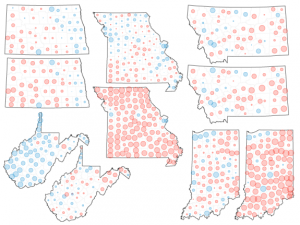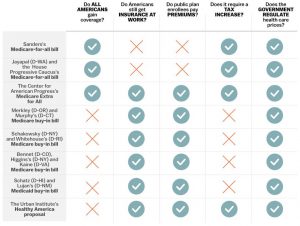At The Washington Post, E. J. Dionne, Jr. previews Nancy Pelosi’s strategy as the House reconvenes with her as Speaker: “The woman who will return as speaker after an eight-year absence sounded almost gleeful in discussing the planks in the House platform. She was characteristically disciplined in sticking to the issues that helped elect the ideologically diverse group of 63 new Democratic members who gave her the opportunity to wield the gavel…At the top of the list is a sweeping political reform package linked to a new Voting Rights Act. Taking on the “special interests,” she said, will “give people confidence” in the rest of the Democratic wish list that includes health care (with a focus on prescription drug prices and protecting people with preexisting conditions), workforce training and “building the infrastructure of America in a green way.” However, “The House’s first order of business is not how she expected to start: the imperative of reopening the government. The House plans to pass a series of spending bills that have already been approved by the Republican-majority Senate. A separate bill would extend existing funding for the Department of Homeland Security (where any money for a wall-like thing would reside) to allow a month of negotiation.”
“Under Republican control during the past eight years, few amendments with broad bipartisan support made it to the floor,” notes Derek Willis at The Upshot. “A ProPublica analysis of congressional voting data shows that from 1991 through 2010, amendments approved with bipartisan majorities made up one of every six amendment votes in the House. Since 2011, they have been only one of every 20 such votes…“That is a remarkable change,” said Frances Lee, a University of Maryland political science professor and author of “Insecure Majorities,” a book about the workings of the modern Congress. “Floor amending is less important than it used to be…From 2007 to 2010, in her first term as speaker, Ms. Pelosi had more amendment votes with bipartisan majorities than any other speaker in recent history. During her final two years in the role, nearly one of every three amendment votes on the floor passed with majorities of both parties voting in favor. But as partisan tensions escalated, she eventually tightened control, allowing only amendments approved by the leadership.”
From Trip Gabriel’s “Voting Issues and Gerrymanders Are Now Key Political Battlegrounds” at The New York Times. “In the November elections, Democrats gained more House seats than they have in any midterm since Watergate, picking up 40 seats. But the gains might have been even bigger, election experts said, if Republican gerrymanders hadn’t been drawn to withstand a blue wave…In Ohio, Republicans won 52 percent of the overall votes for Congress, but they retained 11 of the state’s 16 House seats…In North Carolina, Republicans won 50 percent of the popular congressional vote, but 9 out of 12 seats, not counting one still in dispute…“It’s the result of digitally diabolical gerrymandering,” said Gov. Roy Cooper, a Democrat…Wisconsin’s legislative maps, drawn in 2011, protected Republican supermajorities even after Gov. Scott Walker, a Republican, was defeated last year. Republican candidates for the State Assembly won just 46 percent of the popular vote, but they captured 64 percent of the chamber’s seats…Barry Burden, a political scientist at the University of Wisconsin, called the results “a beautiful gerrymander” because Republicans were protected even in a bad year for their party.”
As for remedies for gerrymandering, Gabriel writes: “In November, voters in Colorado, Missouri, Michigan and Utah approved changes to limit the role of partisanship in drawing congressional and legislative districts. Ohio passed a similar measure in May…But in Missouri, Gov. Michael L. Parson, a Republican, opposed the popular vote to turn over mapmaking to a “nonpartisan state demographer,” which could increase Democratic representation. The governor called for the measure’s repeal…many states have expanded voting access in recent years. Regarding voter registration reform, Gabriel adds, “Midterm voters in Nevada passed automatic registration for those receiving a driver’s license, and Maryland authorized same-day registration at the polls. In New York, Gov. Andrew M. Cuomo is calling for an overhaul of the state’s voting laws, considered among the most archaic in the country.”
This comes from an editorial, “Cleaning the Congressional Stables: The House Democratic class of ’19 is planning a major push on voting, ethics and campaign finance reform. All that stands in the way is the Senate” in The New York Times: “In a September poll for NBC News and The Wall Street Journal, 77 percent of registered voters cited “reducing the influence of special interests and corruption in Washington” as either the “single most” or a “very important” factor in determining their vote for Congress. (Only “the economy” scored higher, with 78 percent.)…Enter H.R. 1, a comprehensive package of revisions to current political practice that House Democrats are looking to introduce in the opening weeks of the next Congress. While the details are still being hashed out, H.R. 1 will attempt to: establish nationwide automatic voter registration; promote online voter registration; end partisan gerrymandering; expand conflict-of-interest laws; increase oversight of lobbyists; require the disclosure of presidential tax returns; strengthen disclosure of campaign donations; set up a system of small-donor matching funds for congressional candidates; and revive the moribund matching-fund system for presidential campaigns. A plan for repairing the Voting Rights Act will move along a separate track.”
The Times editorial continues, “The data suggest that the public has an appetite for taking on campaign finance. A Pew Research poll from May found that 77 percent of Americans favor “limits on the amount of money individuals and organizations” can spend on campaigns. (This includes 71 percent of Republicans and Republican-leaning independents.) Sixty-five percent believe that new laws could effectively reduce the influence of money in politics…At this point, the hunger for reform is so fierce among the Democratic base that the caucus will need to work to temper expectations. While H.R. 1 is near the top of the to-do list of the incoming House speaker, Nancy Pelosi, the package will take a while to make its way to a floor vote. At least five committees have oversight of pieces of it, and even among Democrats there are competing visions for various provisions that must be worked through. Democratic House leaders are hoping to get a bill passed early in the year. And then it is likely to go nowhere fast…One reason H.R. 1 can be so big and bold is that it is mostly an expression of what Democrats would like to do rather than what has any real shot at moving through this divided government…Realistically speaking, enacting even pieces of a bill like H.R. 1 is more of a medium- to longish-term legislative goal. But this does not diminish the urgency of passing the package in the House as a declaration of Democrats’ commitment.”
Brink Lindsey’s WaPo op-ed, “We don’t need to be so polarized. Let’s be pro-market and pro-government,” calls out one of the more destructive false choices being bandied about in political discussions across America: “One of the biggest fault lines in American politics, the long-running ideological dispute over the proper size of government, is based on a false dichotomy. It is time to leave that sterile debate behind…The traditional axis of conflict is “pro-government” on the left and “pro-market” on the right. But to revive the United States’ flagging economic dynamism and ensure that it translates into broadly shared prosperity, we must make bold moves in both directions simultaneously. We need both greater reliance on market competition and expanded, more robust and better-crafted social insurance. We need more government activism to enhance opportunity, as well as less corrupt and more law-like governance. To see these needs and how best to answer them, we have to fashion a new ideological lens: one that sees government and market not as either-or antagonists but as necessary complements.” Lindsey writes that the Niskanen Center, whichj he serves as vice president, embraces a “hybrid policy vision,” which “draws insights from the left and the right, combining liberal awareness of the need for activist government with libertarian recognition of the limits and pitfalls of government action. The resulting policy model is what we call the free-market welfare state.”
Before we get carried away following the 2020 presidential campaign, how about we consider the political contests of 2019? That’s what Ed Kilgore does in his article, “A First Look at the 2019 Elections” at New York Magazine. Kilgore cites “the gubernatorial elections in three states, Kentucky, Louisiana and Mississippi, along with legislative elections in Louisiana, Mississippi, New Jersey, and Virginia. The gubernatorial races are all in states that have leaned heavily Republican in recent years, but they do feature some serious competition and genuine suspense.” Kilgore provides inside detail on each of those elections and also observes that Dems are in good position to add ‘trifecta’ control of Virginia to their assets, going into 2020.
Alexander Hurst’s “Escape from the trump Cult” at The New Republic probes possible techniques for persuading Trump supporters to vote Democratic. Along the way, Hurst offers some salient insights including: “if scandals too numerous to list have not dented faith in Trump, those holding out for an apocalyptic moment of reckoning that suddenly drops the curtain—the Russia investigation, or his taxes—will only be disappointed. In all likelihood, the idea that Trump is a crook has been “priced in.”…Psychologists Rod and Linda Dubrow-Marshall write in The Conversation, it’s extremely difficult for people to admit they are wrong, and it’s crucial for them to arrive at that realization on their own…If we want to bring members of the Trump cult back into the mainstream of American life—and there will be plenty of those who say we should move on without them—resistance means not only resisting the lure of the cult and exposing its lies, but also resisting the temptation to punish its followers…Andrés Miguel Rondón, a Venezuelan economist who fled to Spain, wrote this of his own country’s experience of being caught up in an authoritarian’s fraudulent promises: “[W]hat can really win them over is not to prove that you are right. It is to show that you care. Only then will they believe what you say.”





